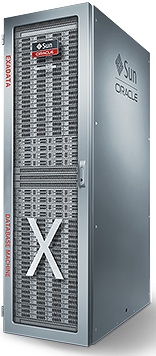Oracle Exadata Database Machine X4
50% to 100% more performance with SSD and 33% to 100% more capacity
This is a Press Release edited by StorageNewsletter.com on December 17, 2013 at 3:04 pmOracle Corp. announced its fifth generation database machine, Exadata Database Machine X4, which features across the board improvements with a focus on improving performance and QoS for OLTP, database consolidation, and data warehousing.

This latest release delivers performance with enhanced uptime and efficiency to help customers streamline operations and take advantage of business critical data.
X4 marks the fifth generation of Exadata, which was launched in 2008. Today, there are thousands of Exadata Database Machine’s powering businesses worldwide, running mission critical workloads including petabyte data warehouses, real-time OLTP, business applications, global scale e-commerce, and online financial trading.
Performance of OLTP-oriented workloads is accelerated by quadrupling the flash memory capacity through a combination of larger physical flash and ultra high-speed flash compression.
A rack Exadata now supports 88TB of user data in flash. This capacity is sufficient to hold the vast majority of OLTP databases entirely in flash memory. Random I/O rates that are critical for OLTP applications have been improved close to 100% to 2.66 million 8K database reads and 1.96 million writes, even with full flash compression enabled. The ability to perform compression at millions of I/Os per second breaks the long standing tradeoff between high performance and high efficiency. Data throughput of a single rack Oracle Exadata is 100GB/s. This throughput exceeds that of all-flash arrays while retaining the benefits of low cost disk tiering.
Performance of data warehousing workloads is accelerated by new flash caching algorithms that focus on table and partition scan workloads that are common in data warehouses. Tables that are larger than flash are now automatically partially cached in flash and read concurrently from both flash and disk to speed throughput.
The performance and capacity of Oracle Exadata allows hundreds of databases to be consolidated in a single rack, enabling reduced costs and improved agility. To further ensure that consolidated environments deliver consistent and predictable performance, Exadata now has the ability to transparently prioritize requests as they flow from database servers, through network adapters and network switches, to storage, and back. It uses a new generation of IB network protocols to ensure that network-intensive workloads such as reporting, batch and backups do not delay response-time sensitive interactive workloads.
Exadata’s enhanced hardware is compatible and interoperable with previously released Exadata Database Machines, enabling customers with existing machines to expand with the new system. Additionally, the new Exadata software supports all previous generation Exadata hardware systems and also supports both Database 12c and Database 11g Release 2.
Improvements over the previous generation include:
- 77% to 100% increase in database I/Os per second. Up to 2.66 million read IO/s per full rack. Up to 1.96 million write IO/s to flash. Exadata flash throughput exceeds that of all-flash arrays.
- 50% increase in database compute performance on X4-2 systems using two 12-core Xeon Processors E5-2697 v2.
- Close to 100% increase in IB network throughput and the addition of Network Resource Management to ensure ultra-low response times for latency critical database operations even when there are network intensive reporting, batch, or backup operations running in parallel.
The X4 improves capacity with the following improvements:
- 100% increase in physical PCI flash capacity to 44TB per full rack.
- Up to another 100% increase in logical flash cache capacity to 88TB per full rack. Flash Cache Compression transparently compresses database data into flash using hardware acceleration to compress and decompress data with zero performance overhead at millions of I/Os per second flash cache compression is effective for both OLTP and DW databases.
- 100% increase in maximum memory capacity on X4-2 to 4TB per full rack using memory expansion kits enables greater consolidation.
- 100% increase in performance disk storage capacity to over 200TB per full rack.
- 33% increase in capacity disk storage capacity to 672TB per rack. Using Exadata compression technologies, petabytes of user data can be stored per rack.
“Oracle Exadata Database Machine is the best platform on which to run the Oracle Database and the X4 release extends that value proposition,” said Oracle president Mark Hurd. “As private database clouds grow in popularity, the strengths of Oracle Exadata around performance, availability and QoS set it apart from all alternatives.”
“Enterprise data center managers are often burdened with the complexity and cost associated with managing data in siloed environments,” said Carl Olofson, research VP at IDC. “Oracle Exadata Database Machine X4 aims to provide database administrators a single, centralized and automated environment to manage databases. The new system’s technology upgrade should deliver significant performance improvements that address the demand to implement Database as a Service, offering the scalability, control and availability to support a full range of database workloads.”













 Subscribe to our free daily newsletter
Subscribe to our free daily newsletter

